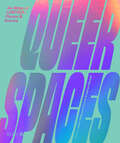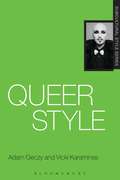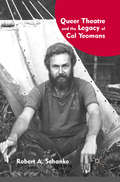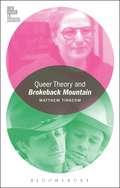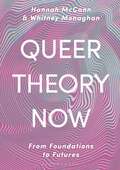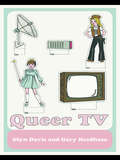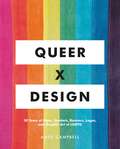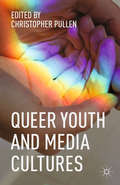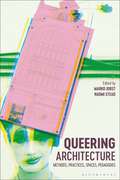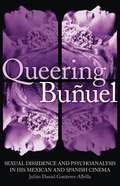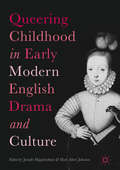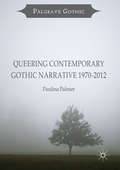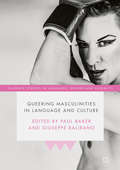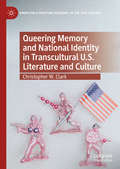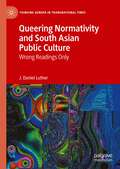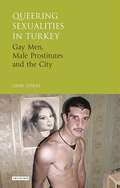- Table View
- List View
Queer Spaces: An Atlas of LGBTQ+ Places and Stories
by Adam Nathaniel Furman Joshua MardellAn independent bookshop in Glasgow. An ice cream parlour in Havana, where strawberry is the queerest choice. A cathedral in ruins in Managua, occupied by the underground LGBTQIA+ community. Queer people have always found ways to exist and be together, and there will always be a need for queer spaces. In this lavishly illustrated volume, Adam Nathaniel Furman and Joshua Mardell have gathered together a community of contributors to share stories of spaces that range from the educational to the institutional to the re-appropriated, and many more besides. With historic, contemporary and speculative examples from around the world, Queer Spaces recognises LGBTQIA+ life past and present as strong, vibrant, vigorous, and worthy of its own place in history. Looking forward, it suggests visions of what form these spaces may take in the future to continue uplifting queer lives. Featured spaces include: Black Lesbian and Gay Centre, London Category Is Books, Glasgow Christopher Street, New York Coppelia, Havana New Sazae, Tokyo ONE Institute for Homophile Studies, Los Angeles Pop-Up spaces, Dhaka Queer House Party, Online Santiago Apóstol Cathedral, Managua Trans Memory Archive, Buenos Aires Victorian Pride Centre, Melbourne
Queer Spaces: An Atlas of LGBTQ+ Places and Stories
by Adam Nathaniel Furman Joshua MardellAn independent bookshop in Glasgow. An ice cream parlour in Havana, where strawberry is the queerest choice. A cathedral in ruins in Managua, occupied by the underground LGBTQIA+ community. Queer people have always found ways to exist and be together, and there will always be a need for queer spaces. In this lavishly illustrated volume, Adam Nathaniel Furman and Joshua Mardell have gathered together a community of contributors to share stories of spaces that range from the educational to the institutional to the re-appropriated, and many more besides. With historic, contemporary and speculative examples from around the world, Queer Spaces recognises LGBTQIA+ life past and present as strong, vibrant, vigorous, and worthy of its own place in history. Looking forward, it suggests visions of what form these spaces may take in the future to continue uplifting queer lives. Featured spaces include: Black Lesbian and Gay Centre, London Category Is Books, Glasgow Christopher Street, New York Coppelia, Havana New Sazae, Tokyo ONE Institute for Homophile Studies, Los Angeles Pop-Up spaces, Dhaka Queer House Party, Online Santiago Apóstol Cathedral, Managua Trans Memory Archive, Buenos Aires Victorian Pride Centre, Melbourne
Queer Style (Subcultural Style)
by Adam Geczy Vicki KaraminasQueer Style offers an insight into queer fashionability by addressing the role that clothing has played in historical and contemporary lifestyles. From a fashion studies perspective, it examines the function of subcultural dress within queer communities and the mannerisms and messages that are used as signifiers of identity. Diverse dress is examined, including effeminate 'pansy,' masculine macho 'clone,' the 'lipstick' and 'butch' lesbian styles and the extreme styles of drag kings and drag queens. Divided into three main sections on history, subcultural identity and subcultural style, Queer Style will be of particular interest to students of dress and fashion as well as those coming to subculture from sociology and cultural studies.
Queer Style (Subcultural Style)
by Adam Geczy Vicki KaraminasQueer Style offers an insight into queer fashionability by addressing the role that clothing has played in historical and contemporary lifestyles. From a fashion studies perspective, it examines the function of subcultural dress within queer communities and the mannerisms and messages that are used as signifiers of identity. Diverse dress is examined, including effeminate 'pansy,' masculine macho 'clone,' the 'lipstick' and 'butch' lesbian styles and the extreme styles of drag kings and drag queens. Divided into three main sections on history, subcultural identity and subcultural style, Queer Style will be of particular interest to students of dress and fashion as well as those coming to subculture from sociology and cultural studies.
Queer Theatre and the Legacy of Cal Yeomans
by R. SchankeA forgotten yet award-winning playwright, Cal Yeomans was one of the founders of gay theater whose work was fueled by gay liberation and extinguished by the AIDS epidemic. Schanke's examination of his life and legacy allows a rare exploration into this pivotal moment of gay American history.
Queer Theory and Brokeback Mountain (Film Theory in Practice)
by Matthew TinkcomQueer Theory and Brokeback Mountain examines queer theory as it has emerged in the past three decades and discusses how Brokeback Mountain can be understood through the terms of this field of scholarship and activism. Organized into two parts, in the first half the author discusses key canonical texts within queer theory, including the work of writers as Judith Butler, Michel Foucault, and Eve Kosofsky Sedgwick. He provides an historical account of the questions these scholars have posed to our understanding of sexualities-both normative and non-normative-in the historical past and in contemporary life, as well as a discussion of the theories of sexuality and gender offered by these scholars as these phenomena shape the experiences of men and women in the genital, bodily, erotic, discursive, and cultural dimensions.The second part examines Ang Lee's 2005 feature film, Brokeback Mountain, in order to understand the claims and insights of queer theory. Tracing the film's adaptation by screenwriter Larry McMurtry of Annie Proulx's 1997 short story of the same title, this portion of the book examines the film's narrative about two working-class men in the rural mid-20th-century U.S. and the meanings of the sexual and emotional bond between the pair that develops over the course of two decades.
Queer Theory and Brokeback Mountain (Film Theory in Practice)
by Matthew TinkcomQueer Theory and Brokeback Mountain examines queer theory as it has emerged in the past three decades and discusses how Brokeback Mountain can be understood through the terms of this field of scholarship and activism. Organized into two parts, in the first half the author discusses key canonical texts within queer theory, including the work of writers as Judith Butler, Michel Foucault, and Eve Kosofsky Sedgwick. He provides an historical account of the questions these scholars have posed to our understanding of sexualities-both normative and non-normative-in the historical past and in contemporary life, as well as a discussion of the theories of sexuality and gender offered by these scholars as these phenomena shape the experiences of men and women in the genital, bodily, erotic, discursive, and cultural dimensions.The second part examines Ang Lee's 2005 feature film, Brokeback Mountain, in order to understand the claims and insights of queer theory. Tracing the film's adaptation by screenwriter Larry McMurtry of Annie Proulx's 1997 short story of the same title, this portion of the book examines the film's narrative about two working-class men in the rural mid-20th-century U.S. and the meanings of the sexual and emotional bond between the pair that develops over the course of two decades.
Queer Theory Now: From Foundations to Futures
by Hannah McCann Whitney MonaghanThis short textbook provides an introduction to queer theory, exploring its key genealogies and terms as well as its application across various academic disciplines and to contemporary life more generally.The authors engage with a wide range of developments in queer theory thinking including discussions of identity politics, transgender theory, intersectionality, post-colonial theory, Indigenous studies, disability studies, affect theory, and more.In offering an updated reflection on the present tensions that queer theory must negotiate, as well as its unfolding future(s), Queer Theory Now is an ideal resource for anyone starting out on their queer theory journey; for students who want to get a grasp of the basic concepts, for teachers looking for a textbook for their queer theory course, or for scholars who want a quick go-to resource for key queer theory ideas and terms.
Queer TV: Theories, Histories, Politics
by Glyn Davis Gary NeedhamHow can we queerly theorise and understand television? How can the realms of television studies and queer theory be brought together, in a manner beneficial and productive for both? Queer TV: Theories, Histories, Politics is the first book to explore television in all its scope and complexity – its industry, production, texts, audiences, pleasures and politics – in relation to queerness. With contributions from distinguished authors working in film/television studies and the study of gender/sexuality, it offers a unique contribution to both disciplines. An introductory chapter by the editors charts the key debates and issues addressed within the book, followed by three sections, each central to an understanding of the relationships between queerness and television: 'theories and approaches', histories and genres', and 'television itself'. Individual essays examine the relationships between queers, queerness, and television across the multiple sites of production, consumption, reception, interpretation and theorisation, as well as the textual and aesthetic dimensions of television and the televisual. The book crucially moves beyond lesbian and gay textual analyses of specific TV shows that have often focussed on evaluations of positive/negative representations and identities. Rather, the essays in Queer TV theorise not just the queerness in/on television (the production personnel, the representations it offers) but also the queerness of television as a distinct medium.
Queer TV: Theories, Histories, Politics
by Glyn Davis Gary NeedhamHow can we queerly theorise and understand television? How can the realms of television studies and queer theory be brought together, in a manner beneficial and productive for both? Queer TV: Theories, Histories, Politics is the first book to explore television in all its scope and complexity – its industry, production, texts, audiences, pleasures and politics – in relation to queerness. With contributions from distinguished authors working in film/television studies and the study of gender/sexuality, it offers a unique contribution to both disciplines. An introductory chapter by the editors charts the key debates and issues addressed within the book, followed by three sections, each central to an understanding of the relationships between queerness and television: 'theories and approaches', histories and genres', and 'television itself'. Individual essays examine the relationships between queers, queerness, and television across the multiple sites of production, consumption, reception, interpretation and theorisation, as well as the textual and aesthetic dimensions of television and the televisual. The book crucially moves beyond lesbian and gay textual analyses of specific TV shows that have often focussed on evaluations of positive/negative representations and identities. Rather, the essays in Queer TV theorise not just the queerness in/on television (the production personnel, the representations it offers) but also the queerness of television as a distinct medium.
Queer X Design: 50 Years of Signs, Symbols, Banners, Logos, and Graphic Art of LGBTQ
by Andy CampbellThe first-ever illustrated history of the iconic designs, symbols, and graphic art representing more than 5 decades of LGBTQ pride and activism.Beginning with pre-liberation and the years before the Stonewall uprising, spanning across the 1970s and 1980s and through to the new millennium, Queer X Design celebrates the inventive and subversive designs that have powered the resilient and ever-evolving LGBTQ movement. The diversity and inclusivity of these pages is as inspiring as it is important, both in terms of the objects represented as well as in the array of creators; from buttons worn to protest Anita Bryant, to the original 'The Future is Female' and 'Lavender Menace' t-shirt; from the logos of Pleasure Chest and GLAAD, to the poster for Cheryl Dunye's queer classic The Watermelon Woman; from Gilbert Baker's iconic rainbow flag, to the quite laments of the AIDS quilt and the impassioned rage conveyed in ACT-UP and Gran Fury ephemera. More than just an accessible history book, Queer X Design tells the story of queerness as something intangible, uplifting, and indestructible. Found among these pages is sorrow, loss, and struggle; an affective selection that queer designers and artists harnessed to bring about political and societal change. But here is also: joy, hope, love, and the enduring fight for free expression and representation. Queer X Design is the potent, inspiring, and colorful visual history of activism and pride.
Queer Youth and Media Cultures
by Christopher PullenThis collection explores the representation and performance of queer youth in media cultures, primarily examining TV, film and online new media. Specific themes of investigation include the context of queer youth suicide and educational strategies to avert this within online new media, and the significance of coming out videos produced online.
QueerBeograd Cabaret: A Shared Space between Queer, Anti-Facism and No Borders Politics (Theater #158)
by Ivana MarjanovicThe clandestine festival QueerBeograd created spaces of critique and transformation in order to foster a politics of interconnectedness. Ivana Marjanovi explores the festival's transnational activist cabaret between 2006 and 2008, which was devised, directed and produced by Jet Moon, a founding member of the QueerBeograd collective. This pioneering study demonstrates how the process of staging QueerBeograd Cabaret created a shared space between queer, anti-fascism and No Borders politics, contributing to the advancement of the intersectionality perspective beyond identity. The study thus investigates historical genealogies of gender and political difference in the former and post-Yugoslav space, bringing these into relation with global social and art movements.
Queere Künstler_innen of Color: Verhandlungen von Disidentifikation, Überleben und Un-Archiving im deutschen Kontext (Image #215)
by Rena OnatQueers of Color kommen in der Kunstgeschichte und in der zeitgenössischen visuellen Kultur entweder gar nicht vor oder aber sie werden als hypersichtbare Andere repräsentiert. Was passiert aber, wenn ihre Perspektiven zum Ausgangspunkt für kritische Auseinandersetzungen mit Rassismus und Heteronormativität in Kunst und visueller Kultur werden? Rena Onat diskutiert die Bedeutung von Queer of Color-Kritik für die Kunst- und Medienwissenschaften. Sie analysiert zeitgenössische Arbeiten von u.a. Hasan Aksaygin, Aykan Safoglu, Sunanda Mesquita und Raju Rage im translokalen deutschsprachigen Kontext. Diese Queers of Color verhandeln dabei mit je spezifischen ästhetischen Praxen Visionen von Disidentifikation, Strategien des Überlebens und Verfahren der Nicht-/Archivierung eigener Geschichten.
Queere Männlichkeiten: Bilderwelten männlich-männlichen Begehrens und queerer Geschlechtlichkeit (Image #228)
by Nicholas ManiuDie zeitgenössische Ikonographie queeren männlichen Begehrens ist das Produkt einer Schichtung und Sedimentierung vergangener Konzeptionen von Geschlecht und Sexualität. Nicholas Maniu analysiert ebendiese wechselhafte Diskursgeschichte von tradierter und devianter Männlichkeit sowie (Homo-)Sexualität. Ausgehend von der Gedankenfigur des Palimpsests legt er die zwischen Oppression und Emanzipation oszillierende Diskursivierung queerer Männlichkeit dar: Von der Päderastie über die Sodomie bis hin zur Pathologisierung verfolgen die Geister der Vergangenheit den homosexuellen Mann bis heute und prägen unweigerlich seine Bilder.
Queering Architecture: Methods, Practices, Spaces, Pedagogies
by Marko Jobst and Naomi SteadFeaturing contributions from a range of significant voices in the field, this volume renews the conversation around what it means to speak of the 'queer' in the context of architecture, and offers a fresh take on the methodological and epistemological challenges this poses to the discipline of architectural theory. Architecture as a discipline, a profession and an applied practice, is always subordinate to its own conceptual framework, which is one of orderliness. It refers to buildings, but also to infrastructures of thought and knowledge, to conventions and taxonomies, to structures of governance, hierarchies of power and systems of administration. How, then, can one look at queering architectural discourse when the very term 'queer', celebrated for its elusive, slippery nature, resists and attacks such order?Divided into four subsections, the essays in this anthology each purse a distinct line of inquiry - methods, practices, spaces, and pedagogies - in order to help particularize the proposed queering of architecture. They demonstrate the paradoxical nature of the endeavour from a diverse range of perspectives – from the questions of mapping queer theory in architecture; to the issues of queer architectural archives, or lack thereof; to the non-Western linguistic challenges to the very term queer alongside decolonial approaches to architecture via indigeneity and landscape.Queering Architecture not only provides a bold challenge to the normative methods employed in architectural discourse but addresses the paradoxical nature of establishing 'queer' methodologies in itself. Essential reading for architectural and queer theorists.
Queering Architecture: Methods, Practices, Spaces, Pedagogies
Featuring contributions from a range of significant voices in the field, this volume renews the conversation around what it means to speak of the 'queer' in the context of architecture, and offers a fresh take on the methodological and epistemological challenges this poses to the discipline of architectural theory. Architecture as a discipline, a profession and an applied practice, is always subordinate to its own conceptual framework, which is one of orderliness. It refers to buildings, but also to infrastructures of thought and knowledge, to conventions and taxonomies, to structures of governance, hierarchies of power and systems of administration. How, then, can one look at queering architectural discourse when the very term 'queer', celebrated for its elusive, slippery nature, resists and attacks such order?Divided into four subsections, the essays in this anthology each purse a distinct line of inquiry - methods, practices, spaces, and pedagogies - in order to help particularize the proposed queering of architecture. They demonstrate the paradoxical nature of the endeavour from a diverse range of perspectives – from the questions of mapping queer theory in architecture; to the issues of queer architectural archives, or lack thereof; to the non-Western linguistic challenges to the very term queer alongside decolonial approaches to architecture via indigeneity and landscape.Queering Architecture not only provides a bold challenge to the normative methods employed in architectural discourse but addresses the paradoxical nature of establishing 'queer' methodologies in itself. Essential reading for architectural and queer theorists.
Queering Buñuel: Sexual Dissidence and Psychoanalysis in His Mexican and Spanish Cinema (International Library of Cultural Studies)
by Julian Daniel Gutierrez-AlbillAs the father of cinematic Surrealism, extensive critical attention has been devoted to Luis Buñuel's cinema. Much has been written about his first Surrealist films of the 1920s and 1930s and the French art movies of the 1960s and 1970s, and analysis of his films has tended to be through the lens of male heterosexuality. However, here for the first time is a queer re-reading of Buñuel's Spanish-language films allowing us to view Buñuel's cinema through a lens of queer spectatorship. Focusing on the films Buñuel produced in Mexico and Spain during the 1950s and 1960s, Julián Daniel Gutiérrez-Albilla argues not that Buñuel's films have a homosexual subplot, but that there are multiple forms of identity, subjectivity and sexuality present in these five representative films. The approach may at first glance seem unusual, given Buñuel's more habitual association with reactionary attitudes, but Gutiérrez-Albilla successfully and convincingly demonstrates that for all his prejudices Buñuel complicates questions of desire and subjectivity in surprising ways.Gutiérrez-Albilla covers Los olvidados (1950), Viridiana (1961), El ángel exterminador (1962), Ensayo de un crimen (1955), and Él (1952), providing the opportunity for detailed analysis. Through these films Gutiérrez-Albilla challenges traditional analysis and proposes that we can re-read Buñuel's Spanish-language films as invalidating the prevalent model of gender, sexual identity and subjectivity within patriarchal and heterosexist ideology. Instead Gutiérrez-Albilla offers the reader a new methodological and theoretical framework to re-read Buñuel's films: he draws on psychoanalysis and contemporary queer and feminist theory, comparing them with Surrealist-informed visual arts. 'Queering Buñuel ' brings together the fields of film studies, feminist and queer theory, Hispanic studies, psychoanalysis and art theory. Gutiérrez-Albilla succeeds in reconceptualizing Buñuel's Mexican and Spanish films beyond geographical, historical and disciplinary boundaries, questioning not just how we see Buñuel, but also how we see cinema.
Queering Childhood in Early Modern English Drama and Culture
by Jennifer Higginbotham Mark Albert JohnstonThis volume analyzes early modern cultural representations of children and childhood through the literature and drama of Shakespeare and his contemporaries. Contributors include leading international scholars of the English Renaissance whose essays consider asexuals and sodomites, roaring girls and schoolboys, precocious princes and raucous tomboys, boy actors and female apprentices, while discussing a broad array of topics, from animal studies to performance theory, from queer time to queer fat, from teaching strategies to casting choices, and from metamorphic sex changes to rape and cannibalism. The collection interrogates the cultural and historical contingencies of childhood in an effort to expose, theorize, historicize, and explicate the spectacular queerness of early modern dramatic depictions of children.
Queering Childhood in Early Modern English Drama and Culture
by Jennifer Higginbotham Mark Albert JohnstonThis volume analyzes early modern cultural representations of children and childhood through the literature and drama of Shakespeare and his contemporaries. Contributors include leading international scholars of the English Renaissance whose essays consider asexuals and sodomites, roaring girls and schoolboys, precocious princes and raucous tomboys, boy actors and female apprentices, while discussing a broad array of topics, from animal studies to performance theory, from queer time to queer fat, from teaching strategies to casting choices, and from metamorphic sex changes to rape and cannibalism. The collection interrogates the cultural and historical contingencies of childhood in an effort to expose, theorize, historicize, and explicate the spectacular queerness of early modern dramatic depictions of children.
Queering Contemporary Gothic Narrative 1970-2012 (Palgrave Gothic)
by Paulina PalmerThis book explores the development of queer Gothic fiction, contextualizing it with reference to representations of queer sexualities and genders in eighteenth and nineteenth-century Gothic, as well as the sexual-political perspectives generated by the 1970s lesbian and gay liberation movements and the development of queer theory in the 1990s. The book examines the roles that Gothic motifs and narrative strategies play in depicting aspects of lesbian, gay, bisexual, transsexual and intersex experience in contemporary Gothic fiction. Gothic motifs discussed include spectrality, the haunted house, the vampire, doppelganger and monster. Regional Gothic and the contribution that Gothic tropes make to queer historical fiction and historiography receive attention, as does the AIDS narrative. Female Gothic and feminist perspectives are also explored. Writers discussed include Peter Ackroyd, Vincent Brome, Jim Grimsley, Alan Hollinghurst, Randall Kenan, Meg Kingston, Michelle Paver, Susan Swan, Louise Tondeur, Sarah Waters, Kathleen Winter and Jeanette Winterson.
Queering Masculinities in Language and Culture (Palgrave Studies in Language, Gender and Sexuality)
by Paul Baker Giuseppe BaliranoHow do we learn what it means to be a man? And how do we learn to question what it means to be a man? This collection comprises a set of original interdisciplinary chapters on the linguistic and cultural representations of queer masculinities in a range of new and older media: television, film, online forums, news reporting, advertising and fiction. This innovative work examines new and emerging forms of gender hybridisation in relation to complex socialisation and immigration contexts including the role of EU institutions in ascertaining asylum seekers’ sexual orientation, and the European laws on gender policy. The book employs numerous analytical approaches including critical discourse analysis, corpus linguistics, multimodal analysis, literary criticism and anthropological and social research. The authors show how such texts can disrupt, question or complicate traditional notions of what it means to be a man, queering the idea that men possess fixed identities or desires, instead arguing that masculinity is constantly changing and negotiated through the cultural and political overlapping contexts in which it is regularly produced. These nuanced analyses will bring fresh insights for students and scholars of gender, masculinity and queer studies, linguistics, anthropology and semiotics.
Queering Memory and National Identity in Transcultural U.S. Literature and Culture (American Literature Readings in the 21st Century)
by Christopher W. ClarkThis book examines the queer implications of memory and nationhood in transcultural U.S. literature and culture. Through an analysis of art and photography responding to the U.S. domestic response to 9/11, Iraq war fiction, representations of Abu Ghraib and Guantánamo Bay, and migrant fiction in the twenty-first century, Christopher W. Clark creates a queer archive of transcultural U.S. texts as a way of destabilizing heteronormativity and thinking about productive spaces of queer world-building. Drawing on the fields of transcultural memory, queer studies, and transculturalism, this book raises important questions of queer bodies and subjecthood. Clark traces their legacies through texts by Sinan Antoon, Mohamedou Ould Slahi among others, alongside film and photography that includes artists such as Nina Berman and Hasan Elahi. In all, the book queers forms of cultural memory and national identity to uncover the traces of injury but also spaces of regeneration.
Queering Normativity and South Asian Public Culture: Wrong Readings Only (Thinking Gender in Transnational Times)
by J. Daniel LutherThis book develops a queer methodology to analyse a queer archive for the impact of normativity on subjecthood and the ways in which it shapes and curtails gender and sexuality. Chapters demonstrate how normativity functions to mask its own operation, is internalised by subjects, and is continually reproduced through discourse and in material ways. In seeking to make visible the functioning of normativity, the book performs a task of queering normativity by querying that which appears as natural in South Asian public culture. The book engages with both the consolidation and the unsettling of normativity through artefacts of South Asian public culture including canonical figures such as Rabindranath Tagore, literary and cinematic texts, Bollywood films, advertisements, social media posts, and ubiquitous ephemera in South Asia and beyond. Through these texts, the author unpacks the construct of canon, the nation, woman as a post-colonial subject, the home and the child, marriage, same-sex sexuality and identity.This book will be of interest to scholars and students studying and researching Queer Studies, Gender and Sexuality Studies, South Asian Studies, Cultural Studies, Literary Studies, Film Studies, and Media Studies.
Queering Sexualities in Turkey: Gay Men, Male Prostitutes and the City (Library of Modern Turkey)
by Cenk ÖzbayDespite its some of its more liberal and democratic characteristics – when compared to many other countries in the Middle East – the more conservative elements within Turkish politics and society have made gains over the past decades. As a result, like many others in the region, Turkish society has multiple standards when naming, evaluating and reacting to men who have sex with men. Cenk Özbay argues that overall, self-identified gay men (as well as men who practice clandestine same-sex acts) are most of the time marginalised, ostracised and rendered 'immoral' in both everyday practices and social institutions. He offers in this book an analysis of the concept of masculinity as central to redefining boundaries of class, gender and sexuality, particularly looking at the dynamics between self-identified gay men and straight-acting male prostitutes, or 'rent boys'. A result of in-depth interviews with both self-identified gay men and rent boys, Özbay explores the changing discourses and meaning of class, gender and queer sexualities, and how these three are embedded within urban and familial narratives.
